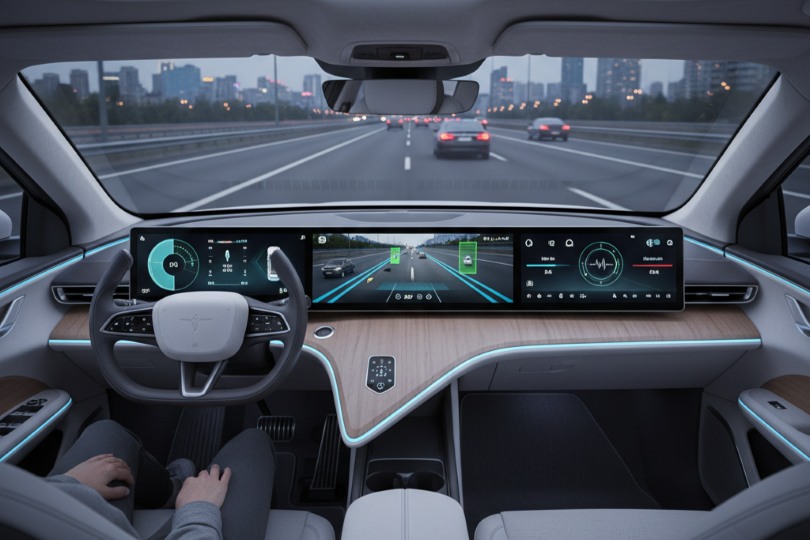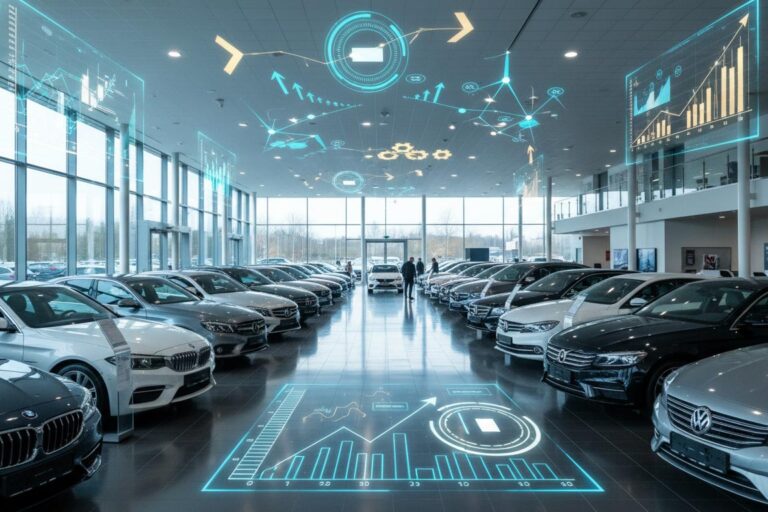What’s Next for Electric Vehicles? The ADAS Service Revolution
Let’s face it—cars are no longer just about getting from Point A to Point B. The auto industry is continuously heading towards extraordinary transformation, and we’re here for it. Nowadays, we can really see how electric vehicles (EVs) are are gaining serious momentum.
Even better? Advanced Driver Assistance Systems (ADAS) service and tech are stepping onto the scene in a big way, blowing the doors off how we think about vehicle safety and efficiency. Such technologies are revolutionizing not just the cars themselves but the way the automotive aftermarket industry operates. It brings unique opportunities on the table.
Now, it’s time to stay ahead of the curve and gear up for what’s coming. Keep on scrolling to know more.
Understanding ADAS in EVs
What is ADAS exactly? In simpler terms, it is a set of sophisticated technologies that are aimed at helping drivers in real-time by monitoring the surrounding of the car. But it is much more than help—it is about attaining foolproof safety and efficiency levels we have been dreaming of.
Major Components of ADAS in EVs
⦿ Sensor Technology: ADAS works like the eyes of the car, using LiDAR, radar, and cameras. These highly advanced systems create a comprehensive and accurate map of the car’s surroundings. It continuously scans for nearby vehicles, pedestrians, and situations that may require intervention.
⦿ AI & Machine Learning: Here comes the brainpower! Artificial intelligence (AI) and machine learning allow vehicles to analyze real-time data, learn about driving habits, and adapt to different situations. Such predictive intelligence plays a huge role in preventing accidents.
⦿ V2X Communication: Vehicles can now “talk” not just to other cars but to traffic lights, road signs, and other infrastructure. Why? To make smarter navigation choices and enable communication that saves time, energy, and most importantly, lives.
ADAS in Electric Vehicles
Magic works when an EV (Electric Vehicle) are incorporated into ADAS. With its environmentally friendly nature, reduced maintenance, and new design, EVs are already the future of the transport market. Add in ADAS now, and you are talking about smarter, safer, and much cooler cars.
ADAS not only increases safety but also streamlines EVs into intelligent transportation. For EV owners who fear range anxiety driven by charging stations, we have some good news. ADAS systems powered by EV-specific data can now optimize routes, monitor battery health, and even anticipate energy consumption.
Related News: See how 5G-powered connected vehicles are shaping the future.
Market Trends in ADAS Adoption
Okay, now let’s go to numbers (because FACTS matter). The ADAS global market is on fire with an impressive growing Compound Annual Growth Rate (CAGR) of 12.2%. With the current USD 42.5 billion in 2024, it is projected to nearly be USD 133.8 billion by 2034. That’s massive, right? But what’s driving this boom?
The Big Drivers to ADAS Growth
- Increased EV Demand. We are witnessing a global shift toward EVs as consumers seek a sustainable future. Along with this change, there is the necessity to use advanced tech to be safe and efficient.
- Self-Driving Innovation. Lane assist further becomes adaptive cruise control and automated parking. And come on, let’s be real. Who does not want a car that drives itself in the future? See how more and more new-car shoppers want autonomous driving technologies and advanced driver-assist features in this recent news.
- Environmental Consciousness. People are becoming environmentally conscious of the traditional cars. ADAS-powered EVs are the new standard of environmentally-friendly vehicles.
- Regulatory Support. Governments worldwide are incentivizing EV adoption and promoting safety-first initiatives through regulations and grants for ADAS implementation.
Challenges in EV/ADAS Service
All right, this is the not so glamorous side of the conversation, the challenges. With these innovative technologies being introduced into our lives, automotive service providers are experiencing some growing pains.
Service Complexity
ADAS technology and EV systems are no longer just regulars. They are based on hi-tech sensors, cameras, LiDAR, and radar technology. Maintaining these systems requires specialized equipment, training, and expertise. Things that will surely not be so easy for a dealership and a repair shop.
Technicians need to understand the intricacies of ADAS integration and EV system repairs. In short, the skillset needed is rapidly evolving. By which, traditional training programs just won’t cut it anymore.
Diagnostic and Calibration Problems
Ever had a customer come in and complain their lane assist was malfunctioning? It is not an easy business to diagnose these problems. Such ADAS systems require proper calibration to make them work the best. A calibration mistake in a camera, such as mishandling, might endanger the driver and the people nearby. Keeping those systems in check and spotting faults early is key.
The Industry Gaps
The kicker here is that there’s currently a lack of standardized service protocols and tooling for EV/ADAS maintenance. That is an enormous impediment to adoption. Thus, technicians should be trained continuously to be on par. This is an excellent chance for the industry to rise up—but we’ll dive deeper into that in a bit.
Opportunities for the Automotive Aftermarket Industry
The aftermarket business is on the edge of something massive. With all the challenges come amazing opportunities. Automotive service providers can play a decisive role in the EV/ADAS journey. Here’s why:
✔ Expanded Service Offerings
EVs with ADAS require careful maintenance—it is that simple. This paves way to expansion of over-the-counter offerings by the aftermarket providers through investment on the correct tools and training programs. It can be in terms of specialized diagnostic apparatus or strong training on technology, but there is a great potential of growth here.
✔ Collaboration Wins
The fact is, no man can be a loner in this fast-changing world. Even tech companies, manufacturers, and service providers will be forced to collaborate to address issues. There should be collaboration to standardize procedures and make sure that there are uniform servicing methods throughout the industry.
✔ Emerging Technologies
The future is bright with further innovation. Artificial intelligence (AI) technologies, increased connection via V2X, and more powerful sensors will establish the future of smarter, greener cars. This implies that the after-market can evolve and innovate more to provide efficient and meaningful services as the technology continues to advance.
Preparing for the Future of EV/ADAS Servicing
Now the big question is, how can you prepare for this technological leap? Three words, education, equipment, standards.
➜ Invest in Technician Training
ADAS technology is not self-maintaining and EV systems are definitely not self-repairing. It is important to invest in training programs for long-term success. Give your technicians continuous training to redefine their skills in diagnostics, calibration, and EV/ADAS service repairs. You would want your team to be ahead of the curve when the competition lags behind.
Assess the possibility of joining a reputable program that will educate your crew on the maintenance of advanced ADAS and EV networks. Unless you are already investing in technician expertise, you will eventually become obsolete, and that is surely not in your business plan.
➜ Adopt Advanced Service Tools
An attempt to work on ADAS-powered EVs with regular combustion-engine repair tools is a recipe for disaster. Remember, it is all about the right equipment. One must invest in specialized tools that can cope with the complexities of ADAS and EV systems. Consider calibration equipment, sensor diagnostic machines, and hardware to handle the technology.
Although it is a fixed cost, it can eventually yield profits when maintenance is streamlined. Furthermore, it is better to avoid the risks associated with shoddy workmanship.
➜ Push for Industry Standards
Here’s where innovation meets advocacy. ADAS and EV services should have common standards imposed on the automotive industry. It is difficult to provide uniform safety and quality without explicit guidelines. Promote regulatory frameworks that establish a roadmap of your team and increase trust throughout the market.
Speaking of advocacy, Chris Collins Inc. is one notable voice pushing for better technician training and standardized service processes. Whether you’re looking to enhance your team’s skills or just keep up with the tech evolution, staying connected with the right automotive guides can make all the difference.
Conclusion
Indeed, the automotive industry is being redefined by ADAS and EVs. They are transforming transportation, focusing on safety, convenience, and sustainability. But as with any great leap forward, it creates unique challenges alongside its promise.
As a service provider, the point is to ALWAYS ADAPT. The automotive aftermarket sector is getting the rare chance to be at the forefront of this technological revolution. Now is the opportunity to establish a safer, smarter, greener transportation.
Become a trendsetter and continue to make progress!
FAQs
What is ADAS in the automotive industry?
ADAS (Advanced Driver Assistance Systems) are technology systems incorporated in cars to improve safety and driving comfort by providing such functionality as automatic braking, lane-keeping assist, adaptive cruise control, and others.
What is ADAS calibration services?
ADAS calibration services include proper adjustment and alignment of the sensors, cameras, and radar systems to make sure they work well. It’s most common after traffic accidents, repairs, or replacements to guarantee vehicle safety and reliability.
What are the two main types of ADAS?
There are two primary categories of ADAS. (1) Active safety systems, those systems that actively work to help the driver avoid an accident (e.g., automatic emergency braking). (2) Passive safety systems, those systems that issue warnings or alerts to help the driver make better decisions in driving (such as blind-spot detection).
—
Author: Maverick Steel is a writer and digital marketer who enjoys connecting the dots for strategy and engaging content. He spent 6 years in secondary education as a proud campus journalist, specializing in editorial and column writing. Holding a bachelor’s degree in Marketing Management, Maverick is also a devoted advocate for positive cyber citizenship and a certified pet lover. When he’s not busy writing, you can catch him hitting the gym or enjoying a matcha latte at the nearest aesthetic coffee shop.







